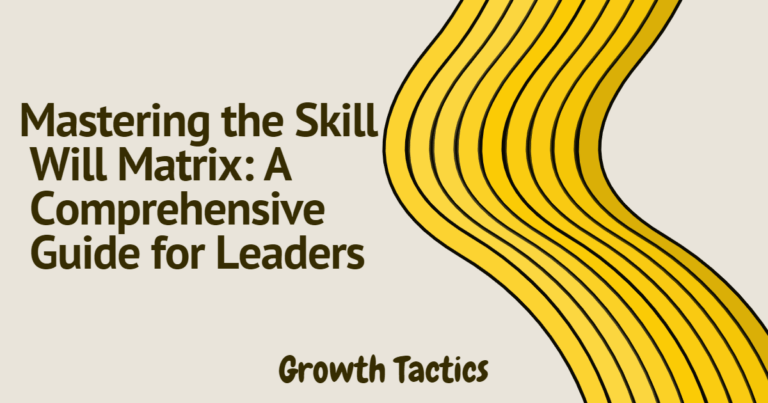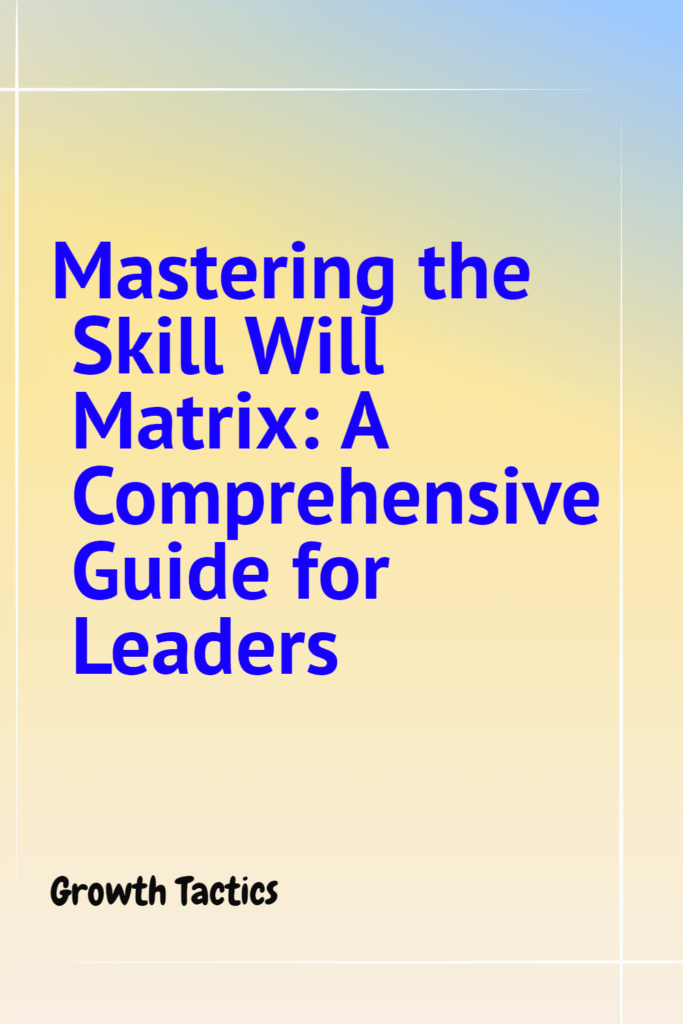The skill will matrix is a tool used to determine the most effective leadership and coaching style for an individual based on their skill level and willingness to perform a specific task or function. This simple 2×2 matrix was originally developed in the 1970s by leadership experts Paul Hersey and Ken Blanchard as part of their situational leadership model.
The purpose of the skill will matrix is to help managers quickly diagnose their team members’ performance to determine the appropriate coaching strategies needed. By plotting an individual on one of the matrix’s four quadrants, leaders can adapt their management style to the situation and individual to maximize performance and engagement.
The key benefit of using the skill will matrix is that it enables leaders to guide their people in the most efficient way possible based on their competency and motivation levels. Rather than using a one-size-fits-all approach, the matrix helps match leadership style to the needs and capabilities of each team member. This tailored coaching helps develop talent, close skill gaps, and build teams that deliver peak performance.

Jump To Section
The Two Dimensions of the Matrix
The skill will matrix has two key dimensions that are plotted on the x and y axes:
- Skill level – This ranges from low to high skill. It looks at a person’s current skill level and proficiency at performing a specific task or function. Someone with low skill lacks proficiency in that particular area. Someone with high skills has strong capabilities and expertise for that task.
- Willingness/motivation level – This ranges from low to high will. It examines the individual’s desire and motivation to perform the task. Low will means the person is reluctant or not motivated to do it. High will means they are eager and willing to take on the task.
These two dimensions allow managers to evaluate both the skill and will of each team member. By plotting employees on these two scales, you can quickly identify skill gaps as well as motivational issues.
The Four Quadrants of the Matrix
The skill will matrix is divided into four quadrants that represent the combination of an individual’s skill level and willingness to perform a task.
Low Skill/Low Will
This quadrant represents team members with a lower skill level and less motivation to complete a task. Employees who fall into this category lack the skills and the will to perform the task at a competent level. As a leader, coaching should focus on providing clear direction and supervision to improve performance. Check-ins and monitoring progress will be important.
High Skill/Low Will
Employees in this quadrant have the skills to successfully complete the task but are less motivated or unwilling to do so. Coaching should aim to provide encouragement and focus on showing the value of performing the task well. Providing a sense of meaning or challenge may improve willingness.
High Skill/High Will
This quadrant represents employees who are both competent and motivated to perform the task well. With high skill and high will, these team members will thrive with delegation and empowerment. Leaders can leverage their skills and motivation by providing opportunities for growth.
Low Skill/High Will
Employees here have a high willingness and desire to perform the task but currently lack the skills to do so successfully. Coaching should focus on training, development plans, and providing resources to improve their skills. With support, motivation can be channeled into building talent.

Using the Matrix to Determine Leadership Style
The skill will matrix enables leaders to quickly determine the most appropriate leadership and management style for each team member based on their skill and will levels. The matrix is divided into four quadrants, each calling for a different approach:
Delegating (Low Skill/High Will): Employees in this quadrant have high willingness but low skills. As they are eager to take on responsibility but currently lack the competence to complete tasks effectively, the appropriate leadership style is to delegate work to them with minimal supervision. Provide overall goals and direction but give them the freedom to carry out the tasks independently. This autonomy will enable them to develop new skills through practice.
Coaching (High Will/Low Skill): For employees who are motivated but need to build skills, the ideal leadership style is coaching. Set aside time for regular check-ins and provide hands-on training to close skill gaps. Ask guiding questions, offer feedback, and work collaboratively to create a development plan. With an emphasis on teaching and encouragement, these employees can rapidly gain new competencies.
Supporting (High Will/High Skill): Team members in this quadrant have both the skill and the will to perform at a high level. Focus on supporting their efforts with resources and empowerment. Provide opportunities for them to take on additional responsibilities and showcase expertise. Celebrate wins, offer guidance when needed, and get out of their way.
Directing (Low Will/Low Skill): Employees lacking both the skill and the motivation to complete tasks require close direction and supervision. Provide clear expectations, structure, and frequent check-ins. Give precise instructions and set step-by-step goals. Closely monitor progress and give corrective feedback regularly. As skill and will increase, look for opportunities to transition to a coaching or delegating style.
How to Plot Your Team on the Matrix
To effectively utilize the skill will matrix, leaders must accurately plot each team member on the matrix based on their skill and will levels. Here are some best practices for this process:
- Assess each employee’s current skill level in performing a particular task or function. Consider their training, experience, and natural abilities. Avoid making assumptions.
- Gauge each individual’s willingness and motivation to complete the task. Look at their attitude, engagement, and performance track record.
- Conduct skill and will assessments individually for each employee. Get input from the employee and observe their work.
- Plot each person on the appropriate quadrant of the matrix according to your assessment of their skill and will levels. This creates a visual profile of your team.
- Identify gaps, needs, strengths, and opportunities. Employees plotted in the lower quadrants likely need training, coaching, or development plans.
- Re-assess periodically and update the matrix as skill and will levels change through coaching, experience, and performance management.
- Use the plotted matrix to determine appropriate leadership strategies for each individual. Match your management style to their needs.
Accurately assessing and plotting each team member provides a simple snapshot of the situation. This enables targeted coaching and development to improve team performance. The matrix must be actively managed to reflect evolving needs.

Coaching Strategies for Each Quadrant
The skill will matrix divides team members into four quadrants based on their skill and will levels. Each quadrant requires a different coaching and management approach to improve performance.
Strategies for Low Skill/Low Will Quadrant
Employees who have low skill and low will require a directing leadership style. They need clear instructions and close supervision to perform tasks. Coaching strategies include:
- Providing specific, step-by-step directions
- Setting clear expectations and deadlines
- Giving frequent feedback on performance
- Asking for input less often as they build skills
- Using positive reinforcement to encourage progress
Strategies for Low Skill/High Will Quadrant
For those with high willingness but low skills, use a coaching style. Provide support to boost their abilities. Strategies include:
- Being patient as skills develop
- Praising effort and willingness to learn
- Offering encouragement through mistakes
- Providing training opportunities
- Giving step-by-step guidance when needed
- Helping set goals and development plans
Strategies for High Skill/Low Will Quadrant
With high skill but low will, use a supporting style. Listen to concerns and provide resources to motivate. Strategies include:
- Understanding reasons for low willingness
- Giving praise for utilizing skills
- Minimizing close supervision
- Encouraging independent decision-making
- Offering new challenges to re-engage
- Providing chances to lead and mentor others
Strategies for High Skill/High Will Quadrant
For those with high skill and will, take a delegating approach. Let them work independently with minimal supervision. Strategies include:
- Expressing confidence in their abilities
- Allowing freedom to complete tasks their way
- Checking in occasionally without micromanaging
- Providing opportunities to lead projects
- Offering challenges to continue growing skills
- Soliciting input to utilize their expertise
Using the Matrix for Development Planning
The skill will matrix is a useful tool for creating development plans for team members. By plotting employees on the matrix, leaders can identify skill or motivation gaps and create strategies to move team members into the “high competence, high commitment” quadrant.
When an employee falls into the “low competence” quadrants, this signals an opportunity to build skills. Leaders should have development conversations to explore how the individual can gain the knowledge, training, and experience needed to become highly competent at a given task. Useful development actions include:
- On-the-job training and coaching
- Job shadowing
- Online courses and reading
- Attending seminars and workshops
For employees who lack motivation, leaders need to inspire commitment. Strategies like the following can help increase an individual’s willingness to accomplish a task:
- Connecting the task to the employee’s goals and interests
- Explaining the significance and impact of the task
- Providing encouragement and recognition
- Involving the employee in planning
- Adjusting the task scope or expectations
By regularly re-assessing team members on the matrix and setting development goals, leaders can facilitate growth. Employees in the top right quadrant are in a position to take on new challenges. The matrix helps match development plans to each individual for a high-performing team.

Adapting the Matrix for Different Situations
The skill will matrix can be adapted beyond its original purpose of determining leadership style. While the matrix was designed with teams in mind, it can also be applied to individuals by assessing an individual employee’s skill and will for a given task.
The two axes can also be modified to assess metrics beyond just skill and will. For example, the axes could be changed to gauge confidence and experience, competency and engagement, or other relevant measures. This provides flexibility to apply the core framework of the four quadrants to many different contexts.
Leaders have adapted the matrix for various purposes, such as:
- Sales team management, with pipeline value on one axis and work ethic on the other
- Marketing campaign planning, with brand awareness on one axis and budget on the other
- Product development, with user feedback on one axis and development cost on the other
The matrix gives leaders a simple visual representation to assess any two variables that impact performance and strategy. While skill and will are most common, the matrix can be customized by changing the axes labels to suit the needs of a particular team, project or situation. This demonstrates the versatility of the tool.
Skill Will Matrix Templates and Tools
The skill will matrix can be depicted visually using a simple 2×2 quadrant diagram. There are many templates available online for creating a quadrant diagram showing the four quadrants of skill and will. These templates can be downloaded and customized in PowerPoint, Word, Excel, Google Slides, Google Docs, and other programs.
In addition to basic quadrant diagram templates, more advanced skill will matrix tools are available. Spreadsheet tools allow managers to plot team members on the matrix, categorize them into quadrants, and use built-in features to determine the recommended leadership style for each individual. Popular spreadsheet tools include the Skill/Will Matrix on Vertex42.com and the Situational Leadership Tool on LeadwithGiants.com.
For a quick and easy way to use the matrix, online calculators can be utilized. By entering numeric ratings for an individual’s skill level and willingness to perform, the calculator will determine the appropriate quadrant and suggested leadership style. Helpful calculators are available on Sites.Google.com, Leaderfactor.com, and TheThrivingSmallBusiness.com.
Whether using a basic template, spreadsheet, or calculator, these skill will matrix tools make it simple for managers to utilize the model when coaching and developing team members. The visual representation and clear recommendations help ensure the matrix is applied effectively.
Best Practices for Using the Skill Will Matrix
The skill will matrix is most effective when used thoughtfully and regularly as a coaching tool. Here are some best practices:
Update assessments regularly – An employee’s skill and will levels can change over time, so it’s important to revisit assessments every few months. Check-in with employees as they take on new projects or responsibilities.
Use matrix as a coaching tool, not a labeling tool – Avoid just slapping labels on people. Have open discussions to understand the context behind skill and will levels. Use the matrix to guide coaching and development.
Customize approach for each individual/situation – While the matrix provides a helpful framework, don’t take a one-size-fits-all approach. Adapt your style to suit each person and situation. Meet employees where they are.
Combine with other tools/approaches – The matrix works best when combined with ongoing career discussions, performance reviews, and professional development planning. Use it as one input, not the sole tool.
Wrapping Up
In conclusion, the Skill Will Matrix is a valuable tool for leaders to assess and develop their team members effectively. By understanding the skill and will levels of each individual, leaders can tailor their approach to coaching and mentoring, resulting in improved performance and job satisfaction. This comprehensive guide equips leaders with the knowledge and practical techniques needed to master the Skill Will Matrix and drive organizational success.


